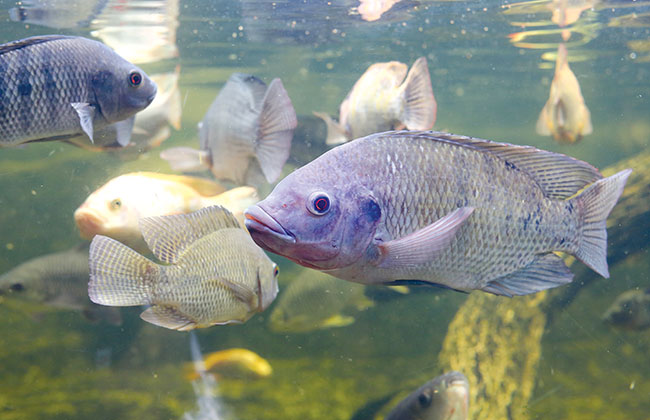
News & Views
Disease Management
Research
Study tests autogenous vaccine to protect Nile tilapia
June 22, 2020 By Nestor Arellano

A bacterium known as Lactococcus garvieae has been wreaking havoc on the relatively young, but fast growing tilapia aquaculture in Zambia.
Commercial farming of Nile tilapia in Zambia began in the 1990s. However, raising tilapia rapidly intensified on Lake Kariba around 2010. The country’s annual production is now around 30,000 metric tons.
The intensified farming has brought the outbreak of disease, according to a recently study by researchers focused on developing a whole bacterial cell autogenous oil-based vaccine for the protection of tilapia against L. garvieae infections.
The pathogenic bacterium L. garvieae, which is known to attack trout, began infecting farmed tilapia in Zambia. Clinical signs include exophthalmia, conjunctivitis, melanosis, erratic swimming, anorexia, internal hemorrhage and congestion of blood vessels, peritonitis, meningoencephalitis and septicaemia.
Farmers have experienced economic losses as mortality rates grew.
Autogenous vaccines
There is no protective commercial vaccine for tilapia available on the market at the moment.
The researchers believed that an autogenous vaccine would be ideal for use in Zambia. Autogenous vaccines are produced on a small to medium scale. They are based on pathogens isolated from a farm on which they are to be used.
These vaccines, according to the researchers, “have the advantage of being less amenable to rigorous regulations applicable to commercial vaccine and allow for more rapid availability without complete and comprehensive characterization in the face of an outbreak.”
Antigens and vaccine for the study were formulated from L. garvieae previously isolated from a diseased fish at a farm on Lake Kariba.
The vaccine was formulated using 109 CFU (colony forming units)/mL as a water-in-oil emulsion using the ISA 763 VG adjuvant (a pharmacological or immunological agent that improves the immune response of a vaccine) from Seppic, France.
The study
A total of 460 healthy Nile tilapia with mean weight of 41.5g ± 16.5g were purchased from Palabana fisheries, a commercial fish farm located in Chirundu district, south east of Zambia. The fish farm had no previous history of disease outbreak.
The fish were transported to the University of Zambia, School of Veterinary Medicine wet-lab. The fish were kept in 500-litre tanks supplied with flow-through dechlorinated water and aerated using stone bubblers. They were allowed to acclimatize for 10 days prior to commencement of the experiment.
The 450 fish were divided into three groups [control (in phosphate-buffered saline, or PBS), adjuvant, and vaccine], each with 150 individuals. The control fish were injected with PBS, the adjuvant group were injected with adjuvant only, and the vaccine group with the L. garvieae vaccine. Each group was further split into two replicates, one for observation (surveillance) and the other for sampling.
Results
Clinical signs of disease were observed mostly in the control (PBS) and adjuvant only groups.
In the adjuvant group, the first onset of clinical signs was on five days post-challenge (dpc ) followed by seven dpc. In the vaccinated group, only two fish showed clinical signs, one at three dpc, likely due to physical injury unrelated to the pathogen challenge, and another one at 14 dpc, this time with corneal opacity.
“Nile tilapia immunized with oil-based L. garvieae vaccine in our study produced significantly higher amounts of antibodies than the control or adjuvant only groups by 21 days post vaccination,” according to the study. “This trend continued until three days post challenge, when the antibody titers [how much specific antibody an organism has produced] dropped sharply.”
The researchers said their findings “suggest that the mechanism for fish protection is achieved is likely via an antibody mediated response.”
The results of the study suggests that tilapia can be vaccinated and protected against L. garvieae by using inactivated oil adjuvanted autovaccines.
Print this page
Advertisement
- CM Aqua appoints new director for Denmark operations
- Deadly virus infect Taiwanese shrimp, crayfish crops





